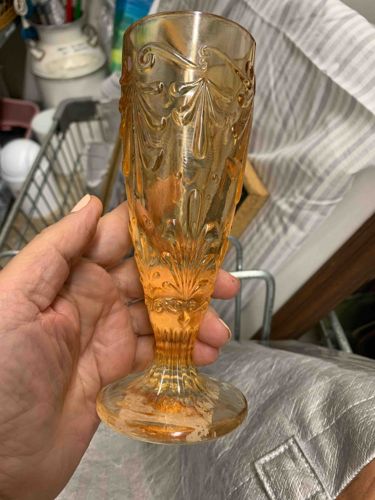
Carnival Glass Short-Stemmed Tumbler or Goblet
This item is a short-stemmed glass in a vibrant marigold or iridescent amber color, characteristic of Carnival Glass. It features a flared base and a cylindrical body that narrows slightly towards the mouth. The glass is heavily embossed with a repeating floral or foliate pattern, appearing primarily on the upper two-thirds of the body. The design includes swirling scrolls, fan-like motifs, and stylized leaves, demonstrating a molded construction. There are vertical flutes or ribs on the stem and around the lower part of the body, transitioning into the main embossed pattern. The iridescence, a hallmark of Carnival Glass, changes hue with light, displaying shifts from golden orange to hints of green and pink. The glass exhibits visible signs of wear and age, particularly on the base and lower body, where there are areas of cloudiness or residue, possibly from hard water deposits or oxidation. This wear detracts from the overall clarity and shimmer in those specific areas. The foot of the glass also shows some staining or discoloration. Given the heavily molded patterns and iridescent finish, it likely dates from the early 20th century, typically 1900-1930s, when Carnival Glass was popular. No specific maker's marks are visible in the provided images, which is common for many pieces of this type of glassware. The craftsmanship is typical of pressed glass techniques of the period, designed for mass production rather than fine artistry, yet it holds decorative appeal due to its color and pattern.
AI-Generated Appraisal Disclaimer
Estimated Value
$10-25
Basic Information
Category
Drinkware / Decorative Glassware
Appraised On
December 3, 2025
Estimated Value
$10-25
Item Description
This item is a short-stemmed glass in a vibrant marigold or iridescent amber color, characteristic of Carnival Glass. It features a flared base and a cylindrical body that narrows slightly towards the mouth. The glass is heavily embossed with a repeating floral or foliate pattern, appearing primarily on the upper two-thirds of the body. The design includes swirling scrolls, fan-like motifs, and stylized leaves, demonstrating a molded construction. There are vertical flutes or ribs on the stem and around the lower part of the body, transitioning into the main embossed pattern. The iridescence, a hallmark of Carnival Glass, changes hue with light, displaying shifts from golden orange to hints of green and pink. The glass exhibits visible signs of wear and age, particularly on the base and lower body, where there are areas of cloudiness or residue, possibly from hard water deposits or oxidation. This wear detracts from the overall clarity and shimmer in those specific areas. The foot of the glass also shows some staining or discoloration. Given the heavily molded patterns and iridescent finish, it likely dates from the early 20th century, typically 1900-1930s, when Carnival Glass was popular. No specific maker's marks are visible in the provided images, which is common for many pieces of this type of glassware. The craftsmanship is typical of pressed glass techniques of the period, designed for mass production rather than fine artistry, yet it holds decorative appeal due to its color and pattern.
Get Your Items Appraised
Instant estimates of your treasures with AI-powered instant appraisals